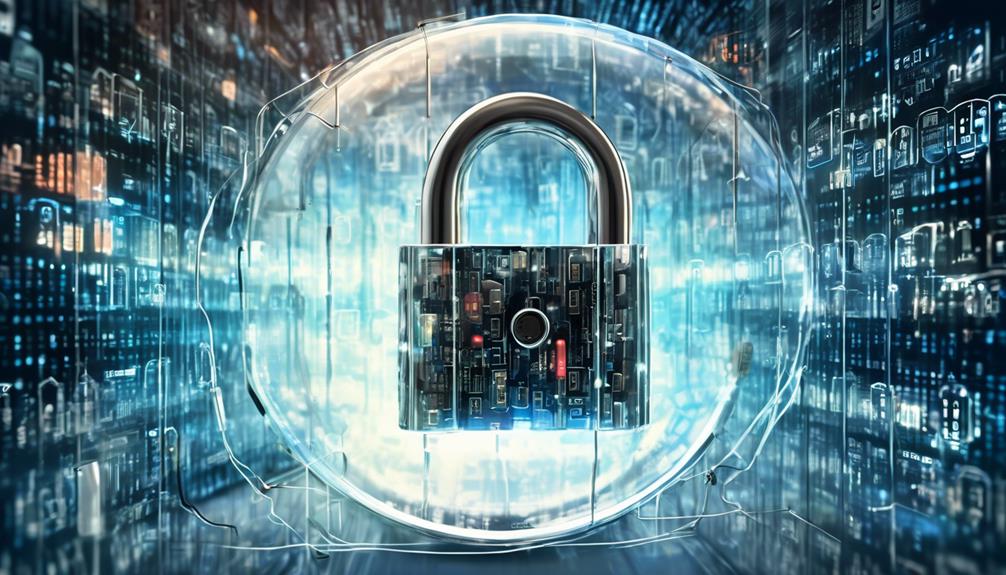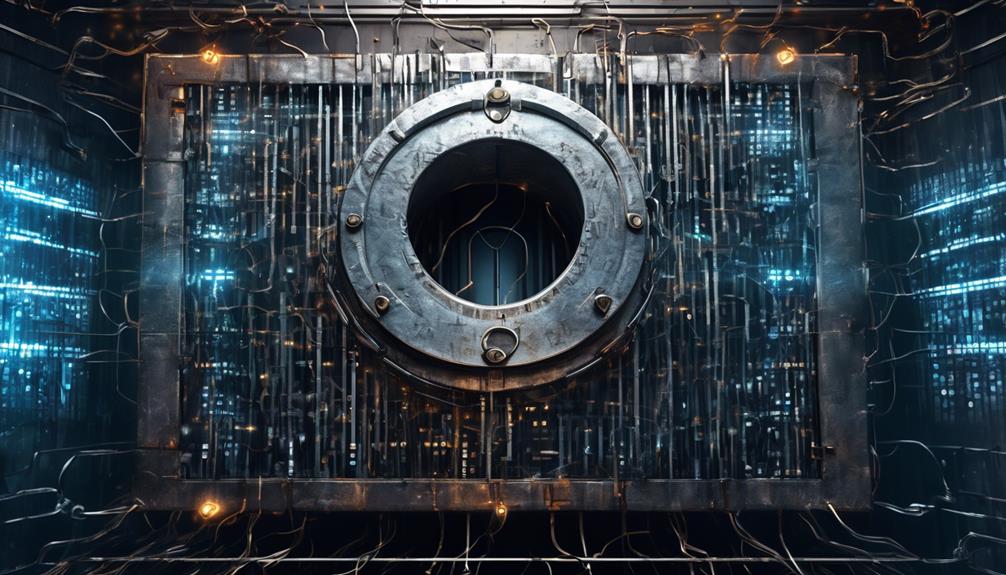In the digital era, financial data breaches are escalating. This increase is tied to the growth in online transactions. Cyber threats are omnipresent, so professionals must be prepared. They need to secure financial information, understanding the risks involved. Secure network connections are essential, and so is strong encryption. However, these steps are just the beginning.
Implementing multi-factor authentication is now a basic necessity. Additionally, recognizing and blocking phishing attempts is critical. Security audits play a key role as well, yet doubts persist. Are our current security measures sufficient for protecting vital financial data? This data is crucial to our global economy's functioning. It's necessary to question whether we need more advanced and creative strategies. Such strategies could strengthen our defenses against continually changing cyber threats.
Understanding Financial Data Risks

Understanding financial data risks is crucial. To secure sensitive information, businesses must prioritize risk assessment. This identifies vulnerabilities that could lead to breaches. The process requires meticulous analysis. Specifically, it examines how financial data is stored, processed, and transmitted. Being proactive, it ensures all organization members understand their data safeguarding roles.
Data breaches can have catastrophic consequences financially and reputation-wise. Establishing a security culture within the organization is essential. Here, every individual feels responsible for protecting client and company data. Regular training and updates on security protocols are necessary. They reinforce the importance of vigilance and preparedness against threats.
Furthermore, staying ahead of risks is an ongoing commitment. It's not a one-time task, but a continuous effort. This approach adapts to emerging threats consistently. The goal is to foster a secure environment where trust is fundamental. For clients and partners to feel secure, they need assurance that their financial data is protected. Thus, it's a collective effort. Indeed, everyone's contribution is vital for the integrity of financial data management.
Secure Network Connections
Establishing secure network connections is essential for protecting financial data. It prevents unauthorized access and combats cyber threats. Within the financial data guardians' community, understanding data segmentation's role is critical. Data segmentation helps protect sensitive information. Organizations create separate network segments, each with distinct security protocols. This strategy reduces the risk of widespread breaches. It also confines damage to a single segment if a breach occurs.
Furthermore, implementing a robust firewall is key. It acts as a gatekeeper for the organization's digital domain. The firewall carefully checks traffic, blocking potential malicious activity. Every finance professional has a shared duty. They must advocate for advanced, regularly updated firewalls. These measures are vital in facing the constantly changing cyber threat landscape.
Data segmentation and firewall implementation together forge a strong defense. They enable the secure exchange of financial data. These are not just technical terms; they are essential shields. The entire financial community depends on them for protection. With each individual's dedication to these security measures, the network's strength increases. Consequently, a shared sense of safety and belonging emerges.
Encryption for Data Safety

Building upon the solid foundation of network segmentation and robust firewalls, encryption serves as the cornerstone of data safety, ensuring that even if financial information is intercepted, it remains unintelligible to unauthorized parties. In the realm of financial data exchange, the stakes couldn't be higher, as sensitive information is constantly in transit, vulnerable to prying eyes.
Encryption employs complex algorithms to transform readable data into a scrambled format, known as ciphertext. This process, data obfuscation, is pivotal in safeguarding data from breaches and exposure. Only those with the correct decryption key can revert the data to its original, readable state, ensuring that sensitive financial details remain confidential and secure.
Financial institutions rely on advanced cryptographic protocols to maintain the integrity and confidentiality of data exchanges. These protocols define the methods for secure encryption and decryption, providing a trusted framework for data transmission. It's a communal effort that reinforces the sense of belonging among stakeholders who share the responsibility of protecting financial information.
As threats evolve, so must encryption techniques. The financial sector must stay abreast of emerging cryptographic trends and continually update their encryption strategies. This proactive approach is essential for maintaining an impregnable defense against cyber threats, and for preserving the trust that clients place in their financial institutions.
Multi-Factor Authentication
Multi-factor authentication (MFA) significantly enhances security during financial data exchanges. It mandates multiple verification forms, ensuring sensitive information is well-protected. Essentially, MFA is a cornerstone of robust password hygiene. A single compromised password isn't enough to cause an unauthorized breach, thanks to MFA.
Financial institutions, by adopting MFA, build a secure user community. Consequently, users feel a strong sense of belonging. They value the additional security steps, confident in the protection of their financial data. Notably, MFA involves three distinct verification elements.
Firstly, it requires knowledge-based information like a password. Secondly, a physical device, usually a mobile phone, is needed. Lastly, MFA incorporates unique biometric data for user identification. The combination of these factors drastically lowers the risk of unwanted access.
Importantly, even with one factor compromised, MFA maintains security. Biometric verification, such as fingerprints or facial recognition, provides personalized security. It is notably difficult to duplicate, adding a robust layer of protection.
Regular updates to MFA methods align with evolving security standards. They ensure continual adherence to best practices in password management. Adopting MFA reflects a dedicated approach to preserving financial security within the community. It shows an investment in advanced, conscientious protection measures.
Recognizing Phishing Attempts

To enhance security, it's essential to spot phishing, which is the fraudulent quest for sensitive data. As a security-conscious community, we must stay alert. Phishing typically features unexpected personal data requests, like passwords or bank details.
One should be especially cautious of emails with dubious links. These may look genuine, yet they often direct to counterfeit websites aimed at stealing credentials. Before clicking, it's shrewd to hover over links to check the URL's legitimacy. An unusual link or a mismatch with the sender's domain usually signals a scam.
Additionally, be on the lookout for email errors, such as misspellings or grammar mistakes. Reputable companies' communications often pass through rigorous reviews before dispatch.
Our community flourishes when each person upholds their digital safety. Being aware of phishing's key indicators helps secure our financial information exchange. After all, email safety is a shared duty, and identifying phishing is crucial for it.
Regular Security Audits
Regular security audits are crucial for safeguarding financial data exchanges. They should happen often enough to deter potential breaches. Additionally, these audits help organizations anticipate and counteract new threats. Through systematic reviews, vulnerabilities are identified, enabling companies to proactively strengthen their security measures.
Audit Frequency Importance
Maintaining data integrity through security audits is crucial. These audits are key for risk assessment and compliance monitoring. They ensure systems are resilient against threats and meet regulatory standards. Regular audits promote a culture of security and accountability. Everyone becomes a stakeholder in safeguarding sensitive information.
There are several reasons for routine audits. Firstly, they identify vulnerabilities, revealing weaknesses early. Secondly, as threats evolve, frequent audits allow organizations to adapt. Thirdly, with changing regulations, regular reviews are necessary to prevent penalties. Lastly, stakeholders trust in the regular scrutiny of their data for protection.
This proactive approach is a cornerstone of ensuring the safety of financial data.
Identifying Vulnerability Areas
Through regular security audits, organizations identify weak points, thus bolstering defenses against financial data breaches. Credential management often surfaces as a key weakness. A thorough audit evaluates authentication process integrity, ensuring that user credentials remain secure. Auditors rigorously ensure employees have only necessary access, thereby reducing internal threat risks.
Furthermore, software updates demand vigilant supervision. Attackers exploit outdated applications; frequent audits ensure systems stay updated and fortified. By consistently examining these elements, the organizational community gains trust in data security. Consequently, this fosters a shared sense of assurance in the protection of their financial information.
Frequently Asked Questions
How Do I Safely Share Financial Data With My Accountant or Financial Advisor Who Is Located in Another Country?
She should use secure encryption for sending financial details abroad. Importantly, practicing data minimization is crucial. This ensures peace of mind within her financial circle.
Are There Any International Regulations or Standards I Should Be Aware of When Exchanging Financial Data Across Borders?
She must take into account GDPR. Additionally, other cross-border compliance laws are crucial. This ensures data sovereignty during international financial exchanges. Consequently, it fosters security. Such security is valued among global partners. This is essential in our interconnected financial world.
What Steps Can I Take if I Suspect My Financial Data Has Been Compromised During an Exchange?
She promptly reaches out to her bank and initiates a credit freeze. Additionally, she arranges for fraud alerts. Joining a vigilant community, she adopts measures to protect her financial identity post-suspicion of a data breach.
How Do Personal Finance Management Apps Ensure the Safety of Financial Data When Syncing With Various Bank Accounts?
Personal finance apps are essential for security. They employ strong data encryption and enforce strict access control measures. Consequently, each synchronization with your bank accounts remains safe. These apps effectively act as guardians, maintaining the privacy of your financial information and ensuring your peace of mind.
What Are the Environmental Impacts of Implementing Advanced Cybersecurity Measures for Financial Data, and How Can Businesses Mitigate These Impacts?
Implementing advanced cybersecurity measures boosts energy use, thus enlarging a firm's carbon footprint. Consequently, companies can counter this by funding green tech. Additionally, they should embrace renewable energy, which promotes community involvement in sustainability.
Conclusion
In conclusion, safeguarding financial data is crucial for any business. Peace of mind is indeed priceless in secure transactions. To ensure this, robust encryption must be implemented. Additionally, secure network protocols are necessary. Moreover, multi-factor authentication strengthens security measures. It's important to stay vigilant against phishing attempts constantly. Businesses, therefore, maintain trust and integrity through these efforts. Regular security audits are not merely prudent. Indeed, they are absolutely essential for maintaining safety. By adhering to these practices, sensitive financial data stays protected. Consequently, a company's reputation as a secure entity is reinforced. This occurs in a digital environment filled with threats.



